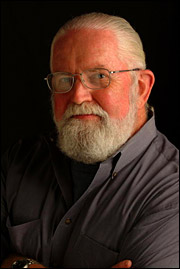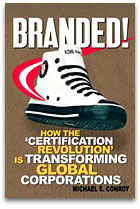
Michael Conroy.
Photo: Chris Conroy Photography
As a shopper, you can’t turn around without running into some type of green label, from Fair Trade to FSC-certified. But what do they all mean, and where the hell did they even come from? Economist Michael Conroy digs into the history behind these increasingly common labels in his book Branded!: How the ‘Certification Revolution’ Is Transforming Global Corporations. He brings to life the campaigns that led to the creation of the Forest Stewardship Council, along with its ongoing challenges from the industry-funded Sustainable Forestry Initiative; the struggles faced by the Marine Stewardship Council and the mind-boggling pledge by Wal-Mart to buy all its ocean-caught seafood from certified sources; the ins and outs of fair trade; and newer pushes in sectors like mining, tourism, and fashion.
Conroy is a former college professor who also spent time at the Ford Foundation and Rockefeller Brothers Fund working on the development of certification systems. Stoutly built and soft-spoken, with a gray ponytail that he says makes a fine accessory to a three-piece suit, Conroy frequently speaks to college students now and exudes optimism about their role in the shift toward more ethical business practices: “It’s driven by young people fresh out of college working as interns, working as campaigners, dedicating themselves to moving these companies toward positions where once and for all they change their practices.”
I caught up with him while he was stationed for a few weeks at Oxford University — part of the “turbo-retirement” he’s now enjoying with his wife — to find out about the certification landscape, the advice he’d give shoppers, and what’s coming down the pike.
Many of the examples in your book involve a sort of public shaming — full-page ads in The New York Times, that sort of thing — to get a company to change its ways. Is that still necessary, or are you seeing a shift toward companies taking the first step?
What we have is a situation where 10 years ago, it took three years of campaigning against Home Depot to get it to change its practices and to give preference to FSC-certified wood … it [took] two years of campaigning against Victoria’s Secret to get it to implement much more recycled and FSC-certified paper in its catalogs, but what there’s been since then is this whole fallout of many, many other companies following suit. In the case of Victoria’s Secret, they made a small but significant commitment to move forward, and the rest of the catalog industry, which was watching what was happening in the campaign, then did a total turnabout, so that many of the major catalog companies quickly shifted to almost exclusively recycled and FSC-certified papers.

FSC-certified lumber has come a long way.
Photo: greenpeace.org
I think that the market campaigns have made companies aware of the fact that they’re vulnerable on their supply chains if they have inappropriate practices that could be identified. I think there are companies that are going ahead on their own to adopt, for example, certified Fair Trade as a measure for as many of their products as they possibly can because see it as the ethical way to run their businesses … I see this whole process like a three-legged stool: one leg is the advocacy campaigns, the second leg is the certification system toward which the advocates can push the companies, and the third leg is internal champions inside the companies stepping forward and saying we’ve got to do this because this is [the ethical choice], and it may also be good business.
Are those internal champions key to getting a business onboard?
I don’t think it’s necessary to have one of those in every company that participates, but in every sector, in every industry, there has to be a visionary like that.
Let’s turn to the consumer side: What advice would you give people who are trying to navigate this world of certification?
There are a variety of ways to learn about the quality of a particular label that’s put on a product: go to the website of the certification organization and find out which major NGOs are backing that label … or go to the websites of groups that you know about and respect — like Greenpeace and NRDC and WWF — and ask about their recommendations on [certified] products.
One of the amazing things about being here at Oxford and around London is that public awareness of … certification systems is so high that all of the major grocery chains are competing in their advertisements, in the Sunday flyers, to talk about what new Fair Trade or FSC-certified or MSC-certified products they have. So here in the U.K. it’s becoming much easier, because the companies themselves are discriminating on the basis of the quality of the label.
What do you think it will take for that [level of awareness] to come to the U.S.?
I think we’re moving there more rapidly than we may be conscious of. I think the fact that mainstream stores are now picking up and greatly expanding the sale of Fair Trade-certified and FSC-certified and MSC-certified products is a very good sign. The range of stores goes all the way from Whole Foods to Sam’s Club … I think we’re only 15 or 20 years away from getting past the tipping point, and the tipping point will come not when everything is certified, but when most consumers will pick up a package and look to see who’s certifying the ethical side of a product.
Fair Trade, FSC, and MSC are good examples of certification systems that now have their legs under them. Is there anything newer that you’re keeping an eye on?
Here’s a very good example … there is an international convention that bans the export of toxic wastes called the Basel Convention … which every nation in world but one has signed. It says you can’t take used electronics and ship them to places like China or Brazil or Africa to be recycled and disposed of because they’re toxic waste. The only country that doesn’t subscribe to that is the U.S.
So there’s a set of groups in the United States that are right now actively pursuing the creation of a certification system just for the U.S. on the appropriate recycling of electronic waste. They already have major buy-in from some of the companies that are most sensitive to this, which includes Hewlett Packard, Dell, and Sony. And they’re in the middle now of putting together what the standards are going to be, what the testing process is going to be, and what companies are going to have to do and show in order to essentially say we are in compliance with the Basel Convention: that means not using prison labor, not using child labor, doing environmentally safe recycling of the heavy metals and other components … that’s a really interesting example of meeting a very specific gap.
These tech companies are under pressure from new European regulations, but it seems like if they could just sneak out of their responsibilities in the U.S., they would — why are they getting involved?
If they could sneak out of it and not have it pointed out by anyone, they would. But in this particular case, Greenpeace, the Silicon Valley Toxics Coalition, and the Basel Action Network … have been chaining them for not abiding in the U.S. with regulations they abide in Europe, by using loopholes in the U.S. to send toxic waste to China — which for them is cheaper, but creating, as I describe in my book, horrendous environmental destruction and health problems … And these companies have now been embarrassed by it — most of them have been embarrassed by it. People can turn to the websites of Greenpeace, SVTC, and BAN to see which companies are still resisting.
When a big company like Wal-Mart announces sustainability plans, the reaction from some environmentalists is, “It’s still Wal-Mart, it can’t be good.” When is a company’s green progress worth celebrating?
What’s really interesting about Wal-Mart is that there are between 70-80 different organizations campaigning against them, reflecting the entire range of issues from women’s issues to immigrant rights to local community issues to environmental issues to wage and working condition issues … the campaign against Wal-Mart is going to continue until Wal-Mart has changed [several issues] across the board.
What’s amazing is the extent to which the [environmental] campaign has been successful … they have accelerated the rate at which they talk about the changes that they’re making, and they have allowed major NGOs like Conservation International, Environmental Defense, and Green Seal to come in and help them create pioneering ways of changing some of their practices …. We can praise them for those changes without giving up analysis which says this is a company that’s dangerously large and capable of doing real damage to all of its competitors as well as to people throughout its supply chain … it doesn’t mean I agree with the way it pays its workers or agree with the damage it does to neighborhoods, but those battles continue to be fought on a different plane.
Every company that makes a move toward greater social and environmental accountability wants to get credit for it … it’s only fair to recognize where they’ve made steps in a direction which is a direction we’d like to see industry go. You can evaluate your purchases on what a company is trying to do, but also weigh it against the problems that the company has.
It feels like it makes a trip to the store a lot more complicated.
But it also is a lot more interesting. We now have the opportunity to look for other qualities that we hadn’t looked at before … it’s easier for me to simply grab Fair Trade or FSC-certified products and not have to worry about reading [and deciphering] the claims on the back of the package …. In the end it simplifies the shopping, although it initially appears to make it more complicated.
It seems clearer than ever that business plays a major role in environmental progress. What would you say to people who still doubt the truth of that?
The old politics of environmentalism, where big corporations were always seen as the enemy and yet we were trying to move them toward practices we wanted, didn’t work very well, until we found ourselves with this combination: a point of leverage with the companies — their concern about their brands; a mechanism for providing independent verification of their compliance with higher standards; and a recognition on the part of the companies that there are people not only in the environmental community but in faith-based communities, student communities, [and elsewhere] who will pay for an ethically certified product.
We now see that we can move companies to do the right thing in ways we were never able to before. That doesn’t mean the companies are necessarily our allies, but we now have the power not to just move a few consumers … we have the power to move major corporations in the direction of greater sustainability and greater social equity. This is a whole new world.



